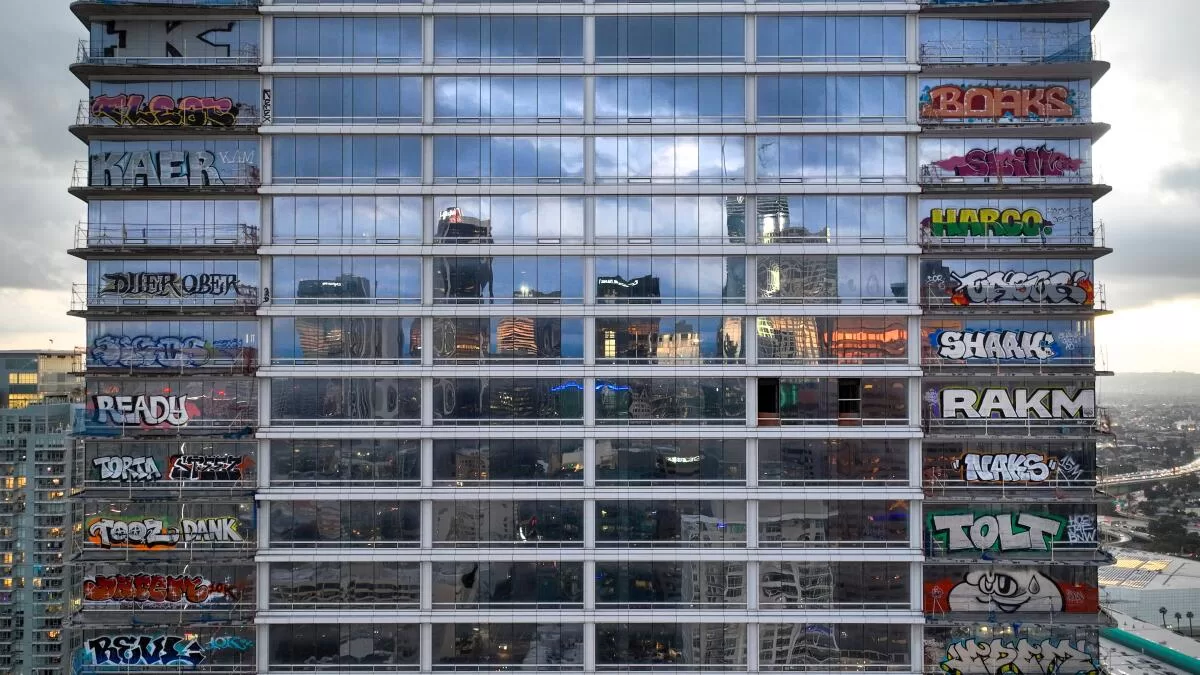Capital fail
In 2019, Beijing-based developer Oceanwide Holdings announced that it was halting construction on a mixed-use mega-development in downtown Los Angeles as it restructured capital for the project. “With more than $1 billion of equity already invested in Oceanwide Plaza, we look forward to investing more capital into the property,” the company said in a statement. Construction, they added, would resume the following month and be complete by the next year.
If only.
For five years, the development, designed by CallisonRTKL, has languished unfinished — ignored by the city around it. That is, until graffiti artists decided to turn the incomplete towers into L.A.’s most photogenic fame wall over the last few weeks. Now Oceanwide Plaza is a global sensation.
“This building has needed love for years,” a tagger named Aker told Hyperallergic’s Matt Stromberg. “If the owners aren’t doing anything about it, the streets of L.A. are happy to make something out of it.”
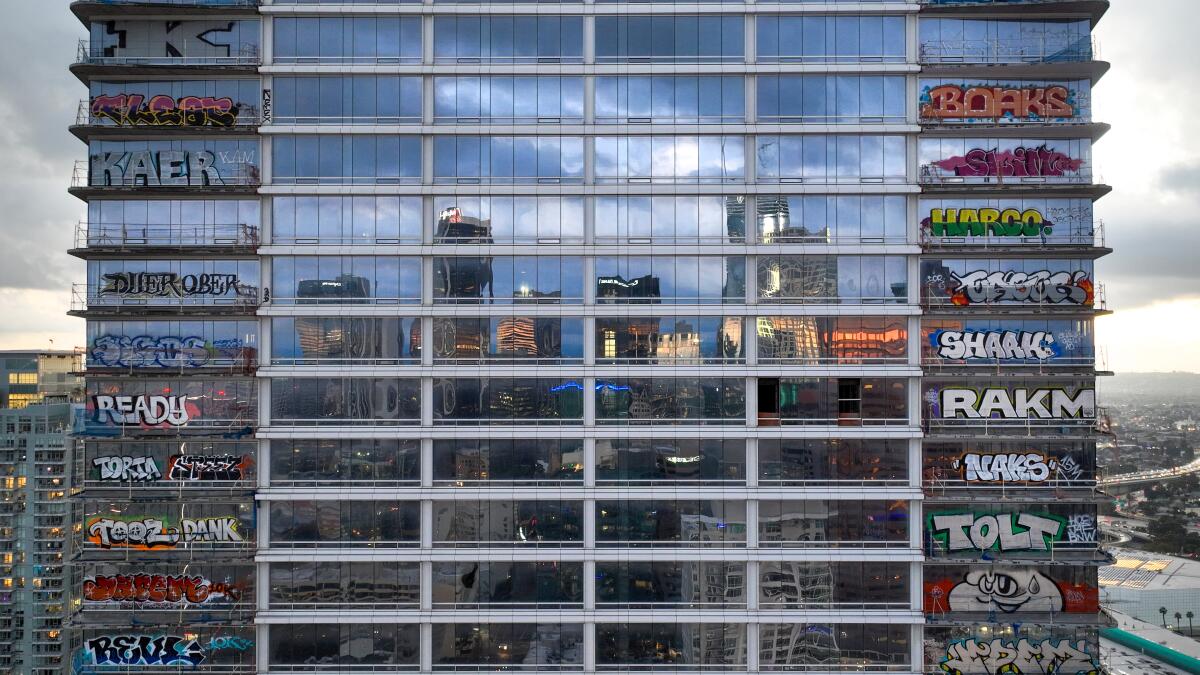
Taggers have graffitied what appears to be more than 25 stories of a downtown Los Angeles development that’s been sitting dormant for several years.
(Robert Gauthier / Los Angeles Times)
I admire the daring nature of the graffiti. (Taggers have a knack for highlighting forgotten urban space.) Though this whole episode is bound to serve as a flagellant in right-wing narratives about failing cities.
If the towers are a symbol of anything, it’s capitalism’s failure to adequately tend to a city’s housing needs — not to mention the L.A. City Council, which has historically jammed these projects through. (A years-long federal corruption probe of City Hall ended with two city councilmen — Mitchell Englander and José Huizar — receiving prison sentences for accepting payouts, gifts, bribes and other graft from developers in exchange for fast-tracking big projects.)
In its staggering failure, however, Oceanwide Plaza is hardly unique. Downtown L.A. now joins the ranks of cities around the globe with uninhabited ghost towers.
Newsletter
You’re reading Essential Arts.
Carolina A. Miranda guides you through the depth and breadth of Southern California’s complex cultural sphere.
You may occasionally receive promotional content from the Los Angeles Times.
One of the most famous is the Caracas skyscraper informally known as the Torre de David, named for David Brillembourg (actual name: Centro Financiero Confinanzas), the financier who built the tower and died in 1993 before the project could be completed. By the following year, Venezuela was knee-deep in a banking crisis and the Torre de David was never completed.
By 2007, the abandoned tower was — rather legendarily — claimed by squatters led by a former gang member known as El Niño, who is said to have ruled the place with an iron fist. Unfinished floor plates harbored an informal community with jerry-rigged water and electrical systems, as well as a dental office and a beauty salon. The tower even materialized in an episode of “Homeland” (though it was played by a fictional set in Puerto Rico).
The Venezuelan government cleared the squatters in 2014, relocating them to government housing in a town south of Caracas. But the Torre de David, in its unfinished state, still stands — albeit precariously. It was damaged in a powerful earthquake in 2018.
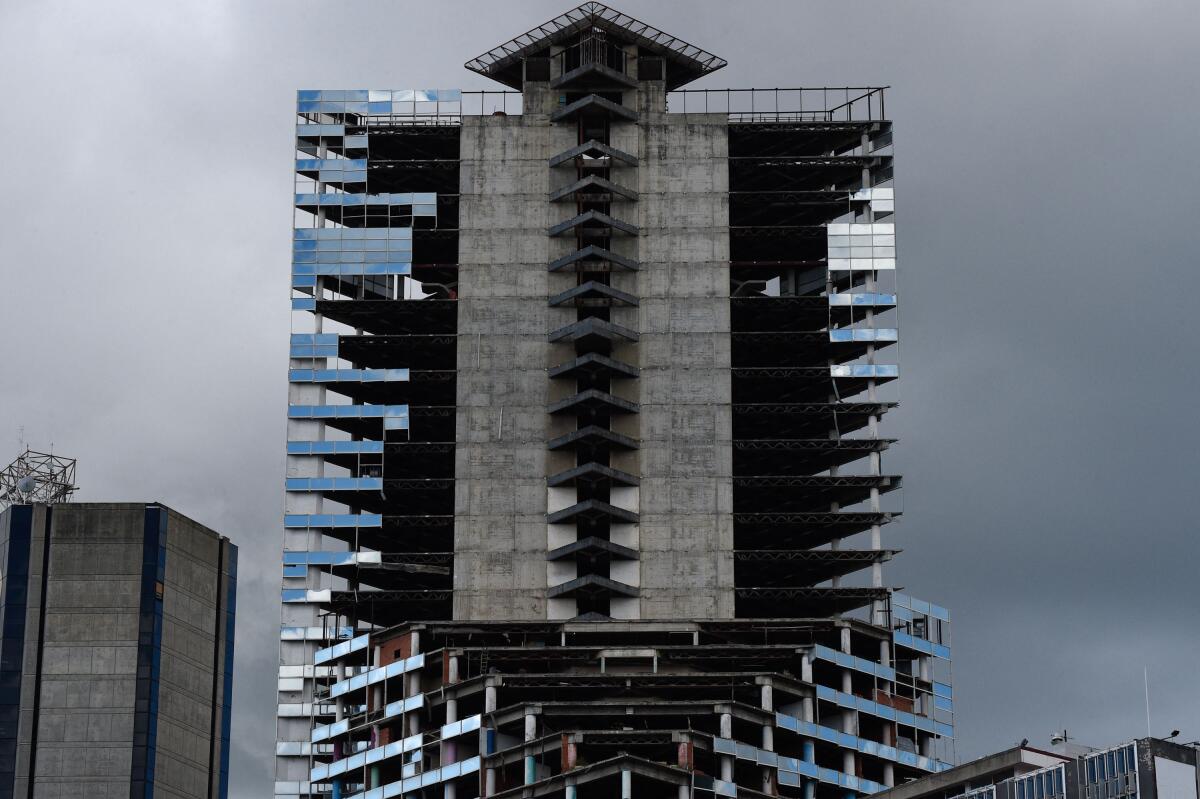
The abandoned skyscraper Torre de David in Caracas, Venezuela in 2018.
(Federico Parra / AFP via Getty Images)
Other city skylines bear their own ghost towers. In New York City, 161 Maiden Lane, a 670-foot tower near the South Street Seaport, known as the Leaning Tower of Manhattan, stands incomplete due to engineering and other problems. In Thailand, the Sathorn Unique Tower rises above the Bangkok skyline like an empty Postmodern hull, victim of the Asian financial crisis in 1997 and an alleged plot by the building’s architect to murder the president of the supreme court. (He was later acquitted.)
And, of course, there’s the infamous Ryugyong Hotel in Pyongyang, North Korea, which was designed to house some 3,000 guest rooms in a mountain-shaped structure that checks in at a height of about 100 stories. Construction broke ground in 1987; to this day, it remains incomplete, having never housed a single guest. Though, in 2018, a local light designer transformed the structure’s skin into a massive LED billboard for the display of propaganda films. (An unheralded precursor to Sphere in Las Vegas.)

A propaganda message is displayed on the facade of the Ryugyong Hotel in Pyongyang in 2018.
(Dita Alangkara / Associated Press)
There can be something exceptionally sinister about a tower — especially a decayed one. “Is there a building type, a kind of architecture, as packed with as many Freudian, political, environmental or otherwise nightmarish meanings?” wrote former Times architecture critic Christopher Hawthorne in a 2016 piece that reflected on J.G. Ballard’s dystopian 1975 novel “High-Rise.” (Unlike the ghost towers of modern cities, however, in the novel, the high-rise in question is completed and comfortably inhabited before falling into violent chaos.)
These mega-developments function as monuments to real estate megalomania, to those who want to build big instead of building what we need. In their incomplete states, they are terrible eyesores. The taggers at Oceanwide Plaza transformed this urban albatross with color and pattern. For that, they have been — and will likely continue to be — arrested. The bigger crime, however, is a luxury development that lies empty as thousands inhabit shanties and tents in the streets below.
In and out of the galleries
At a time in which there is a growing attention to the issue of museums harboring stolen goods, most acts of repatriation take place after a public outcry. But Times art critic Christopher Knight reports on a fascinating case at the UCLA Fowler Museum, where a provenance team, aided by a grant from the Mellon Foundation, found that theft and extortion were behind the removal of several Asante pieces from Africa that ultimately ended up in the Fowler’s collection. Knight hails the move — and gets into the significance of some of the objects in question.
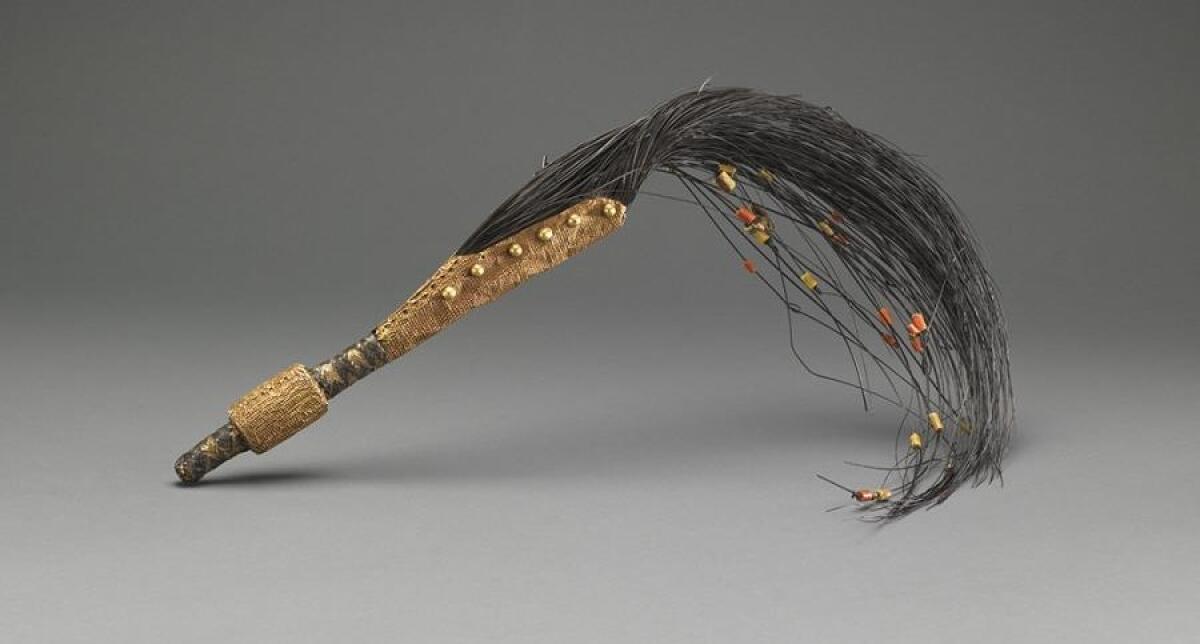
An elephant tail whisk, owned by Kofi Karikari, a king who reigned from 1867 to 1874, is being returned to Ghana’s Manhyia Palace Museum.
(UCLA Fowler Museum)
Artist Salustiano García Cruz made a poster for Seville’s Easter Week depicting a fresh-faced, bare-chested Christ whose nether regions are obscured by a billowing fabric. It has unleashed a torrent of criticism, including that the Christ is “homoeroetic.” “A gay Christ because he looks sweet and is handsome, come on!” said García. “We are in the 21st century.” (Also, have people not been paying attention to centuries of Christian art? Hello, homoeroticism.)
On and off the stage
Sanaz Toossi’s Pulitzer Prize-winning play, “English,” is on the stage at the Old Globe in San Diego. The setting is a classroom in Iran in 2008 where a group of students have come together to learn English for reasons personal and professional. “The old saying about gaining a second soul when you learn a foreign language is invoked,” writes Times theater critic Charles McNulty, “but Toossi is perhaps even more alert to the soul you lose when you are forced to give up your native tongue.”
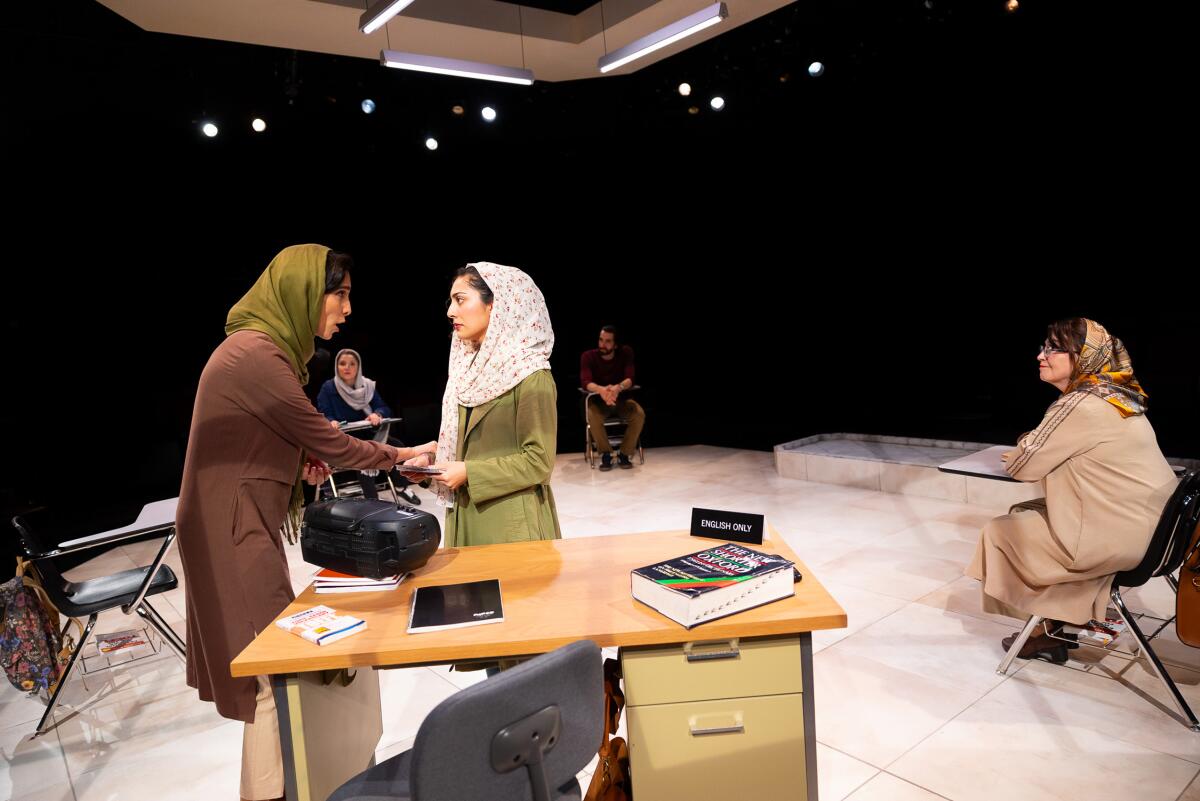
Pooya Mohseni, left, Tara Grammy, Ari Derambakhsh, Joe Joseph and Mary Apick in “English.”
(Rich Soublet II)
“Brushstroke,” a new play by actor-writer John Ross Bowie, now on stage at the Odyssey Theatre, weaves together a tale of Cold War espionage with New York’s downtown art scene during the era of the Abstract Expressionism. Described as a “comedic thriller,” the play’s subject matter, writes McNulty, is “intriguing,” but “Bowie needs to recalibrate his clues into a more decisive dramatic scheme.”
Around the culture
My perambulations on TikTok over the last couple of months have led me to lots of posts in celebration of the cool aunt — otherwise known as the rich auntie, the eccentric aunt, the tía cool or PANK (Professional Aunt No Kids). The cool aunt has been rendered as a bit of a cartoon character, wearer of large sunglasses and even larger handbags. But, as I note in this essay, the unconventional aunt is an important symbol of subversiveness at a time when women’s bodily autonomy is being restricted.

Ego Nwodim, right, plays Rich Auntie With No Kids during “Saturday Night Live’s” Weekend Update with Michael Che.
(Will Heath / NBC)
I’m currently reading Simón López Trujillo‘s 2022 novel “El vasto territorio,” about a deadly strain of fungus that begins materializing in a southern Chilean forest, takes over a woodworker’s mind and turns him into a mystic. All of this makes it a good time to introduce you to California’s new official state mushroom: the California golden chanterelle.
Design time
In preparation for Palm Springs Modernism Week, The Times’ inimitable Lisa Boone pays a visit to a ’50s-era home designed by Palmer & Krisel that has been styled by Josh Agle, the artist otherwise known as Shag. “The house,” she reports, “started as a whimsical idea by branding guru John-Patrick Flynn in 2021: Purchase a run-down Midcentury Modern tract home in Palm Springs and invite Shag to reimagine it as one of his artworks.”

One of the many bright nooks of the Midcentury Modern house designed by Josh Agle (a.k.a. Shag).
(Mariah Tauger / Los Angeles Times)
Plus, Boone also rounds up the shops with the best midcentury gems.
Essential happenings
The Hollywood Bowl‘s summer lineup is out and “Barbie” will be getting the live musical treatment — along with a host of other film offerings. Among the musical acts will be Herbie Hancock, Beck, Rodrigo y Gabriela as well as the West Coast’s first-ever Roots Picnic, featuring Queen Latifah, Digable Planets and many others. Jessica Gelt has all the deets.

Herbie Hancock performs at the Hollywood Bowl in 2010.
(Genaro Molina / Los Angeles Times)
Plus, here’s what I’m looking forward to:
“Only the Young: Experimental Art in Korea, 1960s-1970s,” which opens Sunday at the Hammer Museum.
Painter Karla Díaz will be showing her latest works at the 18th Street Arts Center in Santa Monica, starting Feb. 17. (I interviewed her a few years back about how her strange dreams and bouts of insomnia shape her work.)
Enjoying this newsletter? Consider subscribing to the Los Angeles Times
Your support helps us deliver the news that matters most. Become a subscriber.
Author Carribean Fragoza and historian Romeo Guzmán have resuscitated a house in Zamora Park in El Monte as a cultural space and lending library called C.A.S.A. Zamora. On Saturday, they are holding an opening event that will include readings by Fragoza, Michael Jaime-Becerra, Sesshu Foster and poet-in-residence Steve Valenzuela.
Moves
Mexican curator Amanda de la Garza, previously of the Museo Universitario Arte Contemporáneo in Mexico City, will join the Museo Reina Sofía in Madrid as a deputy director.
Passages
Actor and dancer Hinton Battle, a “dazzling” Tony-winning performer known for his turns in “Sophisticated Ladies,” “The Wiz, “The Tap Dance Kid” and “Miss Saigon,” has died at the age of 67. Of his skill, choreographer Debbie Allen stated: “You were looking at a supernova.”
Alice Mackler, a painter turned sculptor who found prominence in her 80s for her strange, clay figurines, has died at 92.
And because I will always nod to house music in this newsletter: Michael Watford, a church-trained singer who helped give rise to a subgenre known as gospel house, has died at 64.
In the news
— Were some of Vermeer‘s canvases produced by his daughter?
— Art collector Scott Lorinsky has stepped down from two arts boards after it was alleged that he encouraged drivers to ram into pro-Palestinian protesters at a Manhattan demonstration.
— Ai Weiwei criticizes the threat of censorship in the West.
— The Italian junior culture minister accused of laundering a stolen painting has resigned.
— Martin Gelin reviews Bianca Bosker‘s art world expose “Get the Picture.”
— Your weekend read: The terrific Thelma Golden of the Studio Museum in Harlem gets the Calvin Tomkins profile treatment in the New Yorker.
— The rise of techno-authoritarianism.
— How to keep your art out of AI generators.
— San Francisco Chronicle classical music critic Joshua Kosman assesses Michael Tilson Thomas legacy at the San Francisco Symphony.
— The organ playing a 639-year-long John Cage composition changed chords for the first time in two years.
— A staggering visual report from Haaretz on the destruction of Gaza by the Israeli military.
And last but not least …
A coup expert (a.k.a. a comedian from Chile) critiques the Jan. 6 insurrection in the U.S.
